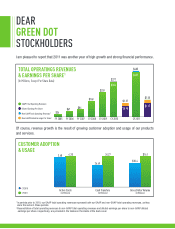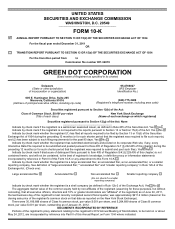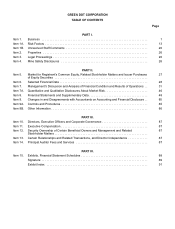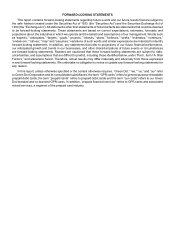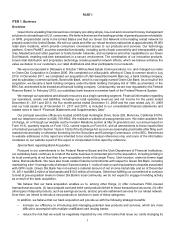Green Dot 2011 Annual Report Download - page 11
Download and view the complete annual report
Please find page 11 of the 2011 Green Dot annual report below. You can navigate through the pages in the report by either clicking on the pages listed below, or by using the keyword search tool below to find specific information within the annual report.1
PART I
ITEM 1. Business
Overview
Green Dot is a leading financial services company providing simple, low-cost and convenient money management
solutions to a broad base of U.S. consumers. We believe that we are the leading provider of general purpose reloadable,
or GPR, prepaid debit cards in the United States and that our Green Dot Network is the leading reload network for
prepaid cards in the United States. We sell our cards and offer our reload services nationwide at approximately 59,000
retail store locations, which provide consumers convenient access to our products and services. Our technology
platform, Green PlaNET, provides essential functionality, including point-of-sale connectivity and interoperability with
Visa, MasterCard and other payment or funds transfer networks, and compliance and other capabilities to our Green
Dot Network, enabling real-time transactions in a secure environment. The combination of our innovative products,
broad retail distribution and proprietary technology creates powerful network effects, which we believe enhance the
value we deliver to our customers, our retail distributors and other participants in our network.
We were incorporated in Delaware in October 1999 as Next Estate Communications, Inc. and changed our name
to Green Dot Corporation in October 2005. We completed our initial public offering of Class A common stock in July
2010. In December 2011, we completed our acquisition of Utah-based Bonneville Bancorp, a bank holding company,
and its subsidiary commercial bank, Bonneville Bank, which is now legally named Green Dot Bank. As a result of the
acquisition, we became a bank holding company under the Bank Holding Company Act of 1956, as amended, or the
BHC Act, and elected to be treated as a financial holding company. Consequently, we are now regulated by the Federal
Reserve Board. In February 2012, our subsidiary bank became a member bank of the Federal Reserve System.
We manage our operations and allocate resources as a single operating segment. Financial information regarding
our operations, assets and liabilities, including our total operating revenues and net income for the years ended
December 31, 2011 and 2010, the five month-period ended December 31, 2009 and the year ended July 31, 2009
and our total assets as of December 31, 2011 and 2010, is included in our consolidated financial statements and
related notes in Item 8 “Financial Statements and Supplementary Data”.
Our principal executive offices are located at 605 East Huntington Drive, Suite 205, Monrovia, California 91016,
and our telephone number is (626) 739-3942. We maintain a website at www.greendot.com. We make available free
of charge, on or through our website via the Investor Relations section at http://ir.greendot.com, our annual report on
Form 10-K, quarterly reports on Form 10-Q, current reports on Form 8-K, and all amendments to those reports filed
or furnished pursuant to Section 13(a) or 15(d) of the Exchange Act as soon as reasonably practicable after filing such
material electronically or otherwise furnishing it to the Securities and Exchange Commission, or the SEC. References
to website addresses in this report are intended to be inactive textual references only, and none of the information
contained on our website is part of this report or incorporated in this report by reference.
Special Note regarding Bank Acquisition
Pursuant to our commitments to the Federal Reserve Board and the Utah Department of Financial Institutions,
our subsidiary bank continues to conduct the same business it conducted prior to the acquisition, including lending in
its local community at not less than its pre-acquisition levels at its single Provo, Utah location, under its former legal
name, Bonneville Bank. We have also made certain financial commitments with respect to Green Dot Bank, including
maintaining a tier 1 leverage ratio of at least 15 percent and a 1:1 ratio of cash or cash equivalents to deposits associated
with GPR cards. Green Dot Bank has not earned a material amount of net income historically and as of December
31, 2011 had $68.2 million of total assets and $10.0 million of net loans. Other than fulfilling our commitment to continue
to lend at pre-acquisition levels in Green Dot Bank's local community, we do not expect to engage in lending activity
as a result of the bank acquisition.
We believe that our bank acquisition enables us to, among other things, (i) offer consumers FDIC-insured
transactional accounts, (ii) issue prepaid card and debit card products linked to those transactional accounts, (iii) offer
other types of deposit products, such as savings accounts, and (iv) provide settlement services for our reload network.
Over time, we intend to introduce new products or services in each of these categories.
In addition, we believe that our bank acquisition will provide us with the following strategic benefits:
•increase our efficiency in introducing and managing potential new products and services, which are more
difficult to accomplish with multiple unaffiliated card issuing banks;
•reduce the risk that we would be negatively impacted by one of the banks that issue our cards changing its




